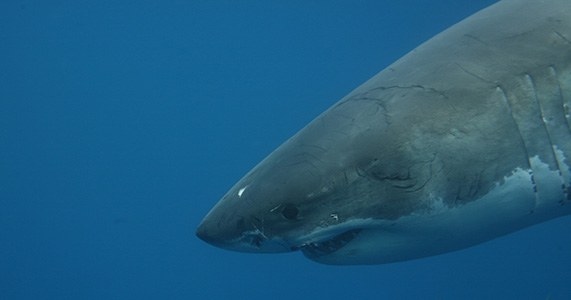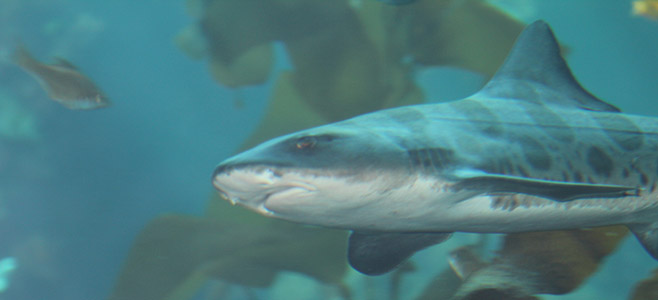Shark! The fin breaks the surface of the San Francisco Bay beneath the Golden Gate Bridge, and the stunned swimmer suddenly turns and scrambles frantically away, seeking to escape the unseen predator.

Great white sharks are normally spotted off the coastline but have been known to enter San Francisco Bay. However, there has never been a recorded great white attack inside the Bay. Photo by David McGuire, SharkStewards.org
By David McGuire
Published: October, 2015
Shark! The fin breaks the surface of the San Francisco Bay beneath the Golden Gate Bridge, and the stunned swimmer suddenly turns and scrambles frantically away, seeking to escape the unseen predator. A scene out of Jaws? The fin turns out to be a flipper of a curious sea lion and, relieved, the Dolphin Club swimmer continues her swim unharassed.
As a local surfer, swimmer and shark conservationist, I frequently hear Jaws-inspired fears of coldblooded killers beneath our treading feet. During the shark film screenings at the San Francisco Ocean Film Festival, or during our Sharktober events with the Gulf of the Farallones National Marine Sanctuary and California Academy of Sciences, people constantly seek assurance that sharks do not swim in the Bay.
But there are sharks here. In fact, thousands of sharks live in San Francisco Bay, and I believe that is a good thing. Many large sharks visit the deeper waters of the Bay, including great white sharks—from here on called “white sharks” because as California Academy of Sciences biologist Dr. John McCosker says, “They are great, and need no superlative.”
Yet despite these large predators poking their heads into the front of the San Francisco Bay, there has never been a recorded white shark attack inside the Golden Gate, with only one confirmed unprovoked shark bite from any shark species inside San Francisco Bay. This occurred in 1926 on a boy and his dog at a whaling station near what is now Oakland Airport. Both survived, and the behavior suggests that it was a sevengill shark, a species that lives and gives birth in the Bay.
This is time of year when most sharks are encountered off our coastline. We call the fall months Sharktober, when the white sharks are more commonly seen off our coastline, and the period when most human-white shark encounters occur along the West Coast. Yet these events are extremely rare, at approximately one fatality per year recorded over the last 100 years.
This summer, with the unusually warm sea temperatures, more juvenile white sharks have been spotted along the coastline. Fourteen white sharks were observed in an unusual aggregation near Santa Cruz in July, and a seal predation was observed by a surfer at Bolinas beach in September. Other kayak and paddleboard bumps have occurred along the coast, but there have been no white shark bites at the time of this writing.
Instead of bumps and bites, most of our sharks are swimming beneath us unseen and harmless. Many species use the Bay estuary to give birth to their pups, as a nursery for the sharks to develop and forage, and for some as a place to breed.
The most common is the lovely leopard shark, a hound shark that grows to about six feet and 70 pounds. These sharks feed on submerged worms, crabs and small fish. Commonly foraging along the bottom, leopards also live along our outer coastline in rocky habitat and kelp beds, and are a diver’s (and angler’s) favorite.
A close cousin, the brown smoothhound, is smaller and shares similar habitat and habits. A schooling shark, the spiny dogfish lives in the Bay and also lives in deeper waters offshore.
This shark, commonly called rock salmon, is caught commercially on the East Coast and exported as a favorite for fish and chips in the United Kingdom and France. Larger sharks also like the taste of spiny dogs, who get their name from their pack-like behavior and the two shark spines in front of the two dorsal fins. Fishermen hate the prick of these spines, but it does not deter the larger Bay sharks like the soupfin and sevengill sharks from eating them.
Soupfin or tope sharks were named by the Chinese immigrants who favored them for the fins to make shark fin soup. We have documented these sharks giving birth inside the Bay, although we do not know if they are seasonal or year-round residents. A slender six-foot shark, they resemble the pelagic blue sharks and range from British Columbia to Baja.
One of the larger sharks that also uses the Bay to reproduce is the enigmatic sevengill. This spotted, perpetually smiling shark has an unusual morphology with one dorsal fin and seven gills. During a tagging program inside the Bay, we have observed male and female sevengills, some over eight feet and over 300 pounds. Sevengill sharks tagged in the Bay have been observed as far south as Baja and as far north as Puget Sound.
Let’s not forget the flat sharks. Several species of skates and rays also live in the Bay. Bat rays forage in the mud; most are around a foot wide but can grow to an enormous four feet in diameter and 130 pounds. Although they are equipped with a stinger, these rays forage in mud shallow on worms, clams and crabs, and human stings are rare. Other flat sharks like the torpedo ray and big skate also live in the Bay.
Several species of large sharks like sixgills, salmon sharks and blue sharks visit the opening of the Bay and nearshore waters. The warm currents this year have brought subtropical species like mako sharks—the fastest fish—and even endangered basking sharks into our National Marine Sanctuary. Like whale sharks, their larger tropical cousins, basking sharks feed on plankton such as krill and larval fish.
What sharks all have in common is that they play an important role and provide important services to the ecosystems they inhabit. Large predatory sharks, in particular, are apex predators that act as architects controlling the populations of species lower in the food chain.
Studies have confirmed that decreasing shark populations can have a negative, domino effect on the health and the balance of the ecosystems they live in. Yet many species of sharks are threatened or endangered; the International Union for the Conservation of Nature has red-listed 25 percent of all species of sharks and rays as endangered. Much of this threat is from overfishing, and in the last few decades the demand for shark fin soup has been putting nails in the coffins of many threatened shark species. This demand, associated with a rise in affluence in China, has lead to an oceanic gold rush for the valued fin, killing as many as 100 million sharks a year.
Shark populations cannot sustain this rate of killing, and the loss is causing untold harm to our ocean ecosystems. That is why the organization Shark Stewards has been a leader in reducing the trade of shark fins and increasing restrictions on killing sharks, including passage of the California shark fin bill initiated here in San Francisco. Today, 10 U.S. states have shark fin trade bans and U.S. shark fin trade has been cut by an estimated 70 percent. Awareness and advocacy have reduced the demand and trade in China too, yet too many sharks are still being killed worldwide. There is still much work needed to save sharks.
As swimmers, surfers and sailors, we are fortunate to have many encounters with wildlife in the Bay, but very few of them are with sharks. If you are like me, you feel fortunate encountering an animal in the wild, and want to continue experiencing wildlife in their element. Sharks are primal, powerful and important to species extending far beyond their own kind. That is why Shark Stewards fights for sharks by stopping the shark fin trade and protecting critical marine habitat, and celebrating sharks through our Sharktober events (see page 22). To learn more about Sharktober and our local sharks, and to support us, visit SharkStewards.org.

Photo by David McGuire, SharkStewards.org

The most common shark found in the Bay is the leopard shark, a hound shark that grows to about six feet and 70 pounds. These sharks feed on submerged worms, crabs and small fish. Photo by David McGuire, SharkStewards.org

